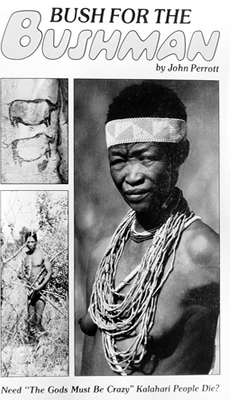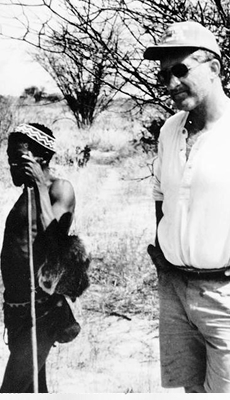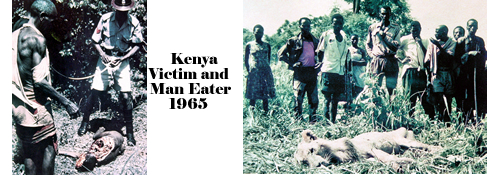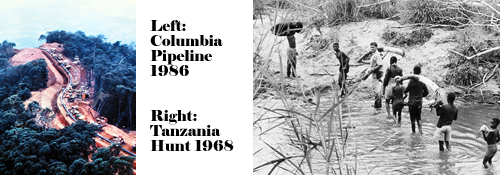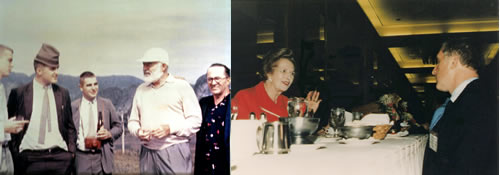|
|||||||||
Site Menu:
US Navy - 1958
Published in 1992, www. savethesan.org With Kalahari Bushman 1988
Photos to the right:
With Ernest
Hemingway, Cuba 1958,
Lady Thatcher knows of the Bushmen through Van der Post and Promises to help.
At the American Booksellers' Association (ABA) Convention in Miami on 1 June 1993. author presents Lady Margaret Thatcher with a copy of "BUSH FOR THE BUSHMAN" |
About the Author The authors story is told in the third person like in court where one addresses the Judge, and relates to oneself as the Defendant or Plaintiff as if a third person entity. Let’s state up front that the author is not an author by profession. Rather someone that has a first hand story or experience to relate—in this case the discovery and birthing of the 1996 version of the Elephant Coast development project. That is in ten months of an exhilarating rags to riches saga and evolution from pursuing New Orleans Jim’s original target (he had published as being 10,000 acres vs. its actual 40,000 acres) to the 585,000 acre (914 Sq Mi) concession version awarded Jim by GOM in 1996. It was only discovered well into the feasibility study that the target area was a UN protected Center of Plant Diversity (CPD) and safeguarding it required the warding off of the looming threat of Humanity and the UN’s CPD being plowed under by a several years prior GOM land concession for a eucalyptus plantation—for wood pulp—to South African Pulp and Paper (SAPPI). The author’s background included graduating from Cal Berkeley in engineering, flying in the US Navy, then joining San Francisco based International Bechtel engineer-constructors for some 30 years of heavy construction (then ongoing semi-retired consulting). That is a career that took him to live and work on every continent but Antarctica, 17 years in Africa. In Africa he was into African wildlife, and indigenous tribes—writing and publishing BUSH FOR THE BUSHMAN (92) a bleeding heart quixotic effort to save their traditional land for the Kalahari Bushman facing death-by-dispossession from their thirst-and-thorn last Kalahari Desert refuge. So this makes a pragmatic-hard-nosed construction-stiff-bleeding heart of our author, an unusual oxymoron. He knows African wildlife from hunting dangerous game as a resident in East Africa—killing a man-eating lion in Kenya in a thicket feasting on a Wakambi tribe adult male in 1965, but more in wildlife photography spending considerable time visiting the major game reserves in East Africa while learning enough Swahili to make it in the bush without needing guides, just Swahili speaking companions.
To make a long
story short, this resulted in a serendipitous outcome, Jim's team
submitting a study for not only the 40,000 acres but rather some 585,000 acres
(914 Sq Mi) which was the then Elephant Coast project (1996 GOM awarded
version). But Jim had serious self inflicted health problems, divorce, substance
abuse. Jim's lawyer who was to be trustee of his estate feared Jim was going to
blow his fortune in Africa, so when Jim went off radar, the lawyer got rid of
the professional team, including your author, and the project fell in a crack,
three years on Jim died, GOM cancelled Jim’s development concession. But your
author and the pros had discovered this diamond-in-the rough jewel in the process,
and feel it must be resurrected to save what could be a challenge to the
Serengeti as the world’s premier wildlife watching destination that must be
safeguarded for future generations of humanity. That is having birthed the
project and knowing its details and virtues, which were lost to GOM in the saga
of them being jilted by the New Orleans entrepreneur, in a bait-then-switch. So this book is about a
CAUSE and
OPPORTUNITY, to save one of
Mother Nature’s few most precious remaining native-and-unspoiled areas that way
for future generations—essentially creating a 4000 Sq Mi National Park. This
whole tale is told in detailed fashion in this book SMEC’s Part II.
|
||||||||
|
www.savemozambiqueselephantcoast.org © 2007
Home Page | Cause and Opportunity | History | Policies | Video Page | Faq's | Links | Contact Graphic Design by Local Tech Service |
|||||||||





